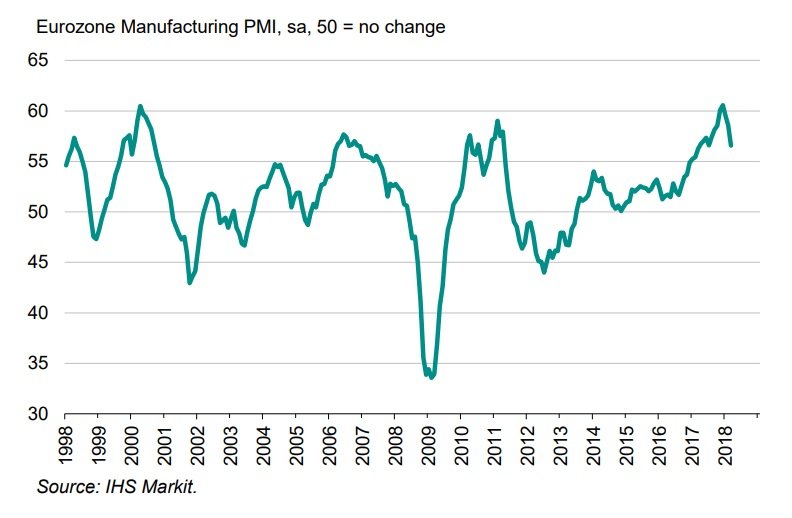The manufacturing activity in the Eurozone decelerated sharply in March with the headline manufacturing purchasing managers index (PMI) cooling off to 56.6 in March, down from 58.6 in February. The growth rate in manufacturing though remains strong by historical standards and the appearance of inflationary pressures will confirm that the ECB policymakers are on the right path towards sustained inflation of close to 2% and can end the era of extraordinary monetary stimulus.
The slowdown in the manufacturing activity to the lowest level in last 8-months is a result of three important factors.
First, it is the base effect of slowdown after the PMI reached multi-year high at the turn of this year and the short-term capacity constraints limit the economy’s ability to grow so quickly for a prolonged period of time.
The second important factor is the fear factor of export-oriented economies of the Eurozone, especially German economy, with the US-led trade wars taking a toll in business confidence. This has been particularly pronounced in German ZEW index of investors’ confidence in March that has decelerated sharply and according to IHS/Markit’s PMI survey, the new export orders fell slipped to a 15-month low.
Appreciation of Euro is feeding through to higher export prices making the life of the Eurozone exporters harder in foreign territories.
This is in fact summed up in the report with Chris Williamson, a chief business economist at IHS/Markit being quoted in March PMI report as saying “the fact that business optimism about the coming year has slipped to a 15-month low suggests there are other factors that are now hitting factory order books. Export growth has more than halved since late last year, linked in part to the appreciation of the euro, and in some cases, demand is being stymied by higher prices.”
Even with the headline manufacturing PMI cooling down in March, the Eurozone growth prospects remain firmly anchored on the upside. With PMI reading well above 50-mark, the economic growth remains robust by historical standards, with all the major Eurozone countries rising strongly, indicating broad-based expansion. And this includes Greece. Manufacturing activity is therefore seen positively contributing to GDP growth in the first quarter, and the appearance of inflationary pressures will be welcomed by policymakers at the European Central Bank.
Manufacturing PMI in Eurozone
Note: All information on this page is subject to change. The use of this website constitutes acceptance of our user agreement. Please read our privacy policy and legal disclaimer. Opinions expressed at FXstreet.com are those of the individual authors and do not necessarily represent the opinion of FXstreet.com or its management. Risk Disclosure: Trading foreign exchange on margin carries a high level of risk, and may not be suitable for all investors. The high degree of leverage can work against you as well as for you. Before deciding to invest in foreign exchange you should carefully consider your investment objectives, level of experience, and risk appetite. The possibility exists that you could sustain a loss of some or all of your initial investment and therefore you should not invest money that you cannot afford to lose. You should be aware of all the risks associated with foreign exchange trading, and seek advice from an independent financial advisor if you have any doubts.
Recommended Content
Editors’ Picks

EUR/USD clings to strong daily gains near 1.0400
EUR/USD remains on track to post strong gains despite retreating from the session high it set above 1.0430. The positive shift in risk mood, as reflected by the bullish action seen in Wall Street, forces the US Dollar to stay on the back foot and helps the pair hold its ground.

GBP/USD surges above 1.2500 as risk flows dominate
GBP/USD extends its recovery from the multi-month low it set in the previous week and trades above 1.2500. The improving market sentiment on easing concerns over Trump tariffs fuelling inflation makes it difficult for the US Dollar (USD) to find demand and allows the pair to stretch higher.

Gold firmer above $2,630
Gold benefits from the broad-based US Dollar weakness and recovers above $2,630 after falling to a daily low below $2,620 in the early American session on Monday. Meanwhile, the benchmark 10-year US Treasury bond yield holds above 4.6%, limiting XAU/USD upside.

Bitcoin Price Forecast: Reclaims the $99K mark
Bitcoin (BTC) trades in green at around $99,200 on Monday after recovering almost 5% in the previous week. A 10xResearch report suggests BTC could approach its all-time high (ATH) of $108,353 ahead of Trump’s inauguration.

Five fundamentals for the week: Nonfarm Payrolls to keep traders on edge in first full week of 2025 Premium
Did the US economy enjoy a strong finish to 2024? That is the question in the first full week of trading in 2025. The all-important NFP stand out, but a look at the Federal Reserve and the Chinese economy is also of interest.

Best Forex Brokers with Low Spreads
VERIFIED Low spreads are crucial for reducing trading costs. Explore top Forex brokers offering competitive spreads and high leverage. Compare options for EUR/USD, GBP/USD, USD/JPY, and Gold.
